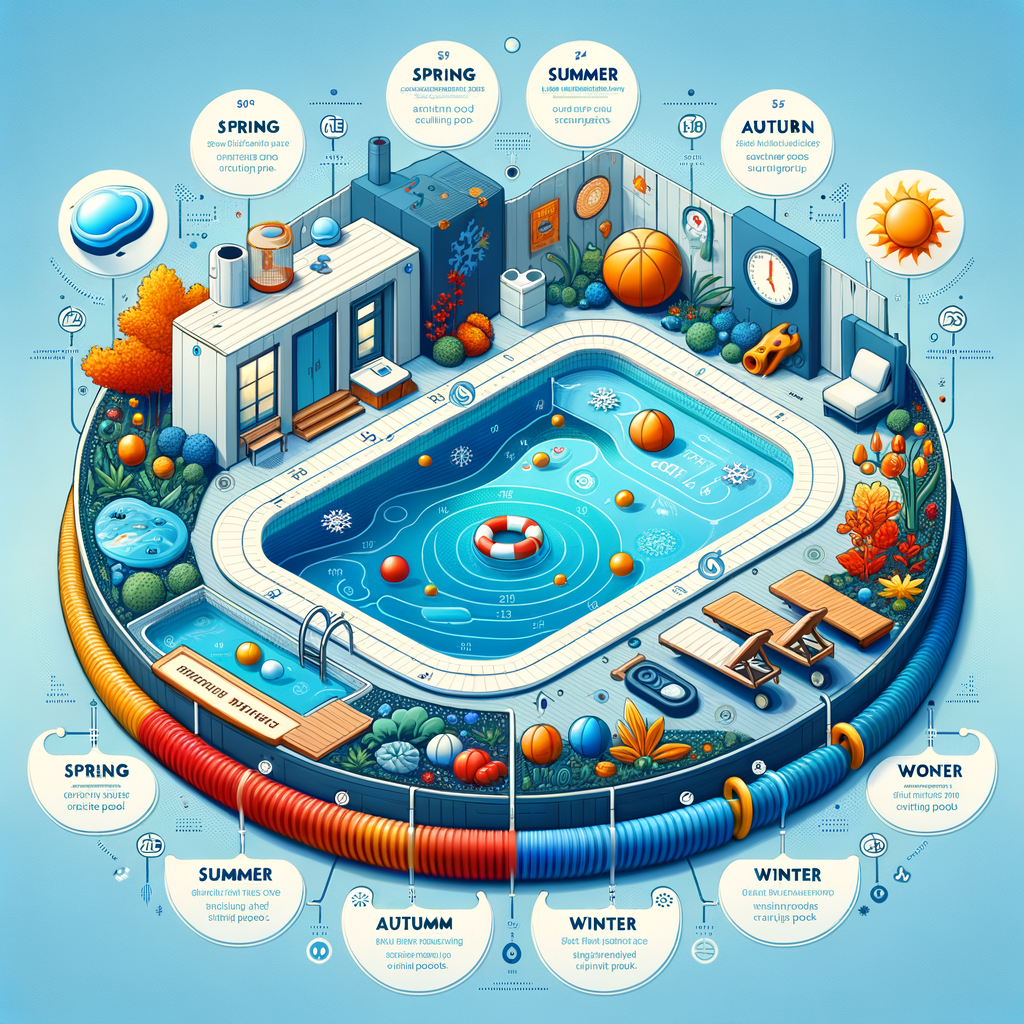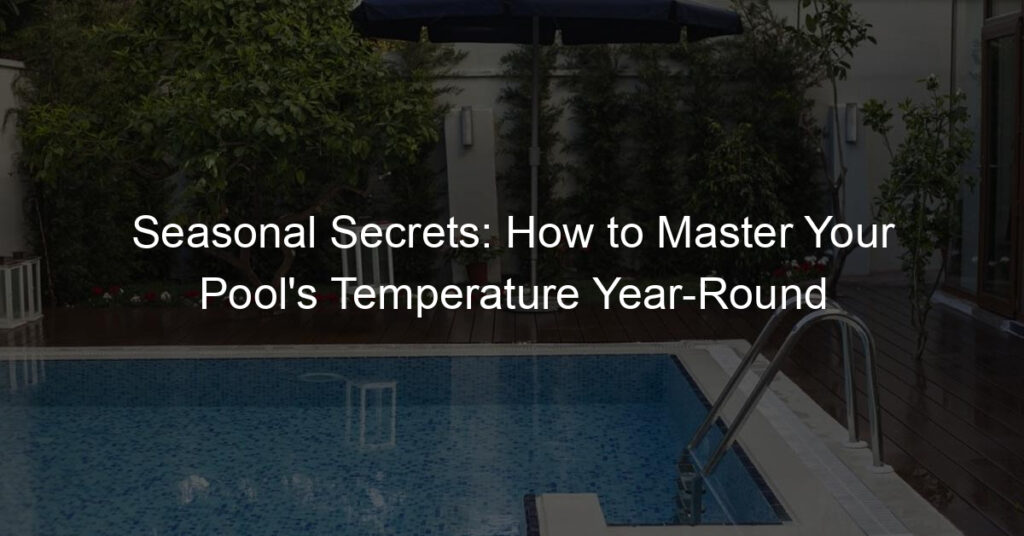
Introduction to Mastering Pool Temperature
Whether you’re a pool owner or a frequent swimmer, understanding how to maintain the right pool temperature is crucial. It not only ensures comfort but also contributes to the overall health and longevity of your pool. In this guide, we’ll delve into the importance of pool temperature control and why year-round pool maintenance is a necessity.
- Understanding the Importance of Pool Temperature Control
- Year-Round Pool Maintenance: A Necessity
Pool temperature control is more than just about comfort. It’s about creating a safe and enjoyable swimming environment. A pool that’s too cold can lead to hypothermia, while one that’s too hot can promote the growth of harmful bacteria. By mastering pool temperature control, you can ensure a safe and comfortable swimming experience for everyone.
Many people think pool maintenance is a summer-only task. However, year-round pool maintenance is essential to keep your pool in top shape. Regular cleaning, checking for leaks, and maintaining the right chemical balance are just a few tasks that need to be done throughout the year. And of course, monitoring and adjusting the pool temperature is a crucial part of this process.
Mastering pool temperature and maintaining your pool year-round may seem like a daunting task. But with the right knowledge and tools, it can be a breeze. So let’s dive in and learn how to keep your pool at the perfect temperature all year round.
Seasonal Pool Tips for Temperature Control
As the seasons change, so too should your approach to pool temperature control. In this section, we’ll explore how to effectively manage your pool’s temperature during the spring season.
Spring Pool Temperature Management
Spring is a time of renewal and rejuvenation. As the cold winter months give way to warmer weather, it’s important to prepare your pool for the upcoming season and adjust its temperature accordingly. Here are some tips to help you navigate this process:
- Prepping your pool after winter
- Adjusting pool temperature for spring
After a long winter, your pool will likely need some TLC. Start by removing any pool covers and cleaning out debris. Then, test the water’s pH, alkalinity, and chlorine levels. If any of these are off-balance, use pool chemicals to correct them. Once your pool is clean and balanced, you can start thinking about temperature.
As the weather warms up, you’ll want to adjust your pool’s temperature to make it more comfortable for swimming. A good rule of thumb is to aim for a water temperature of around 78 to 82 degrees Fahrenheit. You can achieve this by using a pool heater or solar cover. Remember, it’s important to monitor the water temperature regularly to ensure it remains at a comfortable level.
In conclusion, managing your pool’s temperature in the spring involves cleaning and balancing your pool after winter, and then adjusting the water temperature to suit the warmer weather. By following these tips, you can ensure your pool is ready for the spring season.
Summer Pool Temperature Management
As the summer season approaches, managing your pool’s temperature becomes a crucial task. The hot months can cause your pool to become uncomfortably warm, while the cooler summer nights may require some heating. Let’s explore some effective strategies to keep your pool at the perfect temperature throughout the summer.
- Keeping your pool cool during hot months
During the hot summer months, the sun’s rays can heat your pool to uncomfortable levels. Here are some tips to keep your pool cool:
- Use a pool cover: A pool cover can help reduce the amount of heat absorbed by the water during the day. It also prevents water evaporation, which can contribute to the pool’s heat.
- Install a pool cooler: Similar to an air conditioner, a pool cooler can help lower the temperature of your pool water.
- Run your pool pump at night: Running your pool pump during the cooler night hours can help circulate the cooler water throughout the pool.
- Effective pool heating tips for summer nights
While the summer days can be hot, the nights can sometimes be cool. Here are some effective ways to heat your pool during summer nights:
- Use a pool heater: A pool heater is the most effective way to increase your pool’s temperature. There are various types of pool heaters available, including gas heaters, electric heaters, and solar heaters.
- Use a solar cover: A solar cover can help retain the heat in your pool during the cooler nights. It works by trapping the heat from the sun during the day and releasing it into the pool at night.
- Use warm lighting: Installing warm lights around your pool can also help increase the temperature of your pool water.
By following these tips, you can ensure that your pool remains at a comfortable temperature throughout the summer, allowing you to enjoy your pool day and night.
Fall Pool Temperature Management
As the leaves start to change color and the air becomes crisp, it’s time to consider how to manage your pool’s temperature during the fall season. Let’s dive into some key strategies to ensure your pool remains enjoyable and safe as the weather cools.
- Maintaining optimal pool temperature as weather cools
As the weather cools, maintaining a comfortable pool temperature becomes a bit more challenging. But don’t worry, with a few simple steps, you can keep your pool at an optimal temperature. The ideal pool temperature ranges between 78 to 82 degrees Fahrenheit. Here are a few tips:
- Use a pool heater: Pool heaters can help maintain a consistent temperature, especially during chilly fall nights.
- Invest in a solar cover: Solar covers can trap the heat from the sun during the day and keep your pool warm at night.
- Monitor the temperature: Regularly check your pool’s temperature to ensure it remains within the ideal range.
- Preparing for winter: Pool temperature tips
As fall progresses, it’s essential to start preparing your pool for the winter months. Here are some tips to help you transition smoothly:
- Gradually lower the temperature: Instead of abruptly shutting off your pool heater, gradually lower the temperature to avoid shocking the pool’s system.
- Use a winter pool cover: A winter pool cover can protect your pool from debris and help maintain a stable temperature.
- Consider a pool closing service: If you’re unsure about winterizing your pool, consider hiring a professional pool closing service.
| Fall Pool Temperature Tips | Benefits |
|---|---|
| Use a pool heater | Maintains a consistent temperature |
| Invest in a solar cover | Traps heat during the day, keeps pool warm at night |
| Monitor the temperature | Ensures pool remains within the ideal range |
| Gradually lower the temperature | Avoids shocking the pool’s system |
| Use a winter pool cover | Protects pool from debris, maintains stable temperature |
| Consider a pool closing service | Ensures your pool is properly winterized |
In conclusion, managing your pool’s temperature during the fall requires a bit of planning and regular maintenance. By following these tips, you can ensure your pool remains enjoyable and safe throughout the season.
Winter Pool Temperature Management
Winter is a time when many pool owners often worry about how to maintain their pools. The freezing temperatures can be harsh on your pool if not properly managed. This section will provide you with essential tips on protecting your pool during freezing temperatures and keeping the pool temperature stable throughout the winter season.
- Protecting Your Pool During Freezing Temperatures
- Winter Pool Maintenance: Keeping Pool Temperature Stable
Freezing temperatures can cause significant damage to your pool, especially if it’s not properly winterized. When water freezes, it expands, which can lead to cracks in the pool’s structure, damaging the pipes and filtration system.
One way to protect your pool is by using a pool cover. A pool cover prevents debris from entering the pool and reduces the amount of water that evaporates, which can help maintain a stable temperature. It also prevents the water from freezing solid, protecting the pool’s structure.
Another method is to keep the pool’s circulation system running. This keeps the water moving, making it harder for it to freeze. However, this method may increase your energy bills.
Keeping your pool temperature stable during winter can be a challenge. However, it’s crucial for the longevity of your pool and for those brave enough to take a winter dip.
One way to maintain a stable temperature is by using a pool heater. Pool heaters can keep the water at a comfortable temperature, even in freezing conditions. However, they can be costly to run, so it’s essential to use them judiciously.
Another method is to use a thermal pool cover. These covers not only protect your pool from debris but also help retain the heat in the water, keeping the temperature stable.
Lastly, regular monitoring of the pool’s temperature is crucial. This allows you to make necessary adjustments to the pool’s heating system or cover usage to maintain a stable temperature.
In conclusion, winter pool temperature management is crucial to protect your pool from damage and maintain a comfortable swimming environment. By following these tips, you can enjoy your pool year-round, regardless of the weather conditions.
Year-Round Pool Maintenance: A Comprehensive Guide
Keeping your swimming pool in top-notch condition all year round requires a good understanding of pool temperature management. In this guide, we will delve into how to maintain the perfect pool temperature for every season.
Pool Temperature for Every Season
Pool temperature plays a crucial role in determining the comfort of your swimming experience. It’s important to understand how seasonal temperature fluctuations impact your pool and how to adjust your pool temperature accordingly.
- Understanding seasonal temperature fluctuations
- Adjusting your pool temperature accordingly
Seasonal temperature fluctuations can significantly affect your pool’s temperature. In the summer, the hot sun can cause your pool water to heat up, making it uncomfortably warm. Conversely, in the winter, the cold air can cause your pool water to cool down, making it too chilly for a comfortable swim. Understanding these fluctuations is the first step towards maintaining the perfect pool temperature year-round.
Once you understand how seasonal temperature fluctuations affect your pool, you can take steps to adjust your pool temperature accordingly. In the summer, you might need to cool your pool down by using a pool cover or adding cold water. In the winter, you might need to heat your pool up by using a pool heater or a solar cover. By adjusting your pool temperature according to the season, you can ensure a comfortable swimming experience all year round.
Mastering pool temperature control is a crucial part of year-round pool maintenance. By understanding seasonal temperature fluctuations and adjusting your pool temperature accordingly, you can enjoy a comfortable and refreshing swim no matter the season.
Tips for Year-Round Pool Temperature Management
Managing your pool’s temperature throughout the year can seem like a daunting task. However, with the right tools and knowledge, it can be a breeze. Here are two essential tips to help you maintain the perfect pool temperature all year round.
- Using Pool Covers Effectively
- Investing in a Quality Pool Heater
One of the simplest and most cost-effective ways to manage your pool’s temperature is by using a pool cover. Pool covers work by reducing the amount of heat that escapes from the water, especially during the cooler months. They also prevent debris from entering the pool, making maintenance easier.
When using a pool cover, ensure it covers the entire surface of the pool. This will maximize its effectiveness in retaining heat. Remove the cover during the day to allow the sun to naturally heat the water and replace it in the evening to trap the heat.
Another effective way to manage your pool’s temperature is by investing in a quality pool heater. Pool heaters allow you to control the temperature of your pool, regardless of the weather conditions.
There are various types of pool heaters available, including gas heaters, electric heaters, and solar heaters. Gas heaters are known for their ability to heat pools quickly, while electric heaters are more energy-efficient. Solar heaters, on the other hand, are the most environmentally friendly option.
When choosing a pool heater, consider factors such as your budget, the size of your pool, and your heating needs. A good pool heater may be a significant investment, but it will ensure that you can enjoy your pool all year round.
In conclusion, effective pool temperature management involves using pool covers and investing in a quality pool heater. By implementing these tips, you can enjoy a comfortable swim regardless of the season.
Case Studies: Successful Pool Temperature Control
Let’s take a look at two case studies that highlight the triumphs of maintaining a consistent pool temperature throughout the year and overcoming seasonal challenges in pool temperature management.
- Case Study 1: Maintaining a Consistent Pool Temperature Year-Round
- Case Study 2: Overcoming Seasonal Challenges in Pool Temperature Management
Meet John, a pool owner in Florida. John wanted to keep his pool at a comfortable 78 degrees Fahrenheit all year. He invested in a high-quality pool heater and a solar pool cover. The heater worked to raise the pool’s temperature during the cooler months, while the solar cover helped retain the heat, reducing the heater’s workload. This combination allowed John to maintain his desired pool temperature throughout the year.
John’s pool temperature data for a year:
| Season | Average Pool Temperature (°F) |
|---|---|
| Winter | 78 |
| Spring | 78 |
| Summer | 78 |
| Fall | 78 |
Next, we have Sarah, a pool owner in New York. Sarah faced the challenge of managing her pool temperature due to the city’s harsh winters and hot summers. She decided to use a pool heater for the winter and a pool cooler for the summer. The heater helped increase the pool’s temperature during the cold months, while the cooler helped lower the temperature during the hot months. This strategy helped Sarah overcome the seasonal challenges in pool temperature management.
Sarah’s pool temperature data for a year:
| Season | Average Pool Temperature (°F) |
|---|---|
| Winter | 78 |
| Spring | 80 |
| Summer | 76 |
| Fall | 78 |
In conclusion, both John and Sarah were successful in controlling their pool temperatures. They used different strategies based on their specific needs and local climate conditions. Their success shows that with the right equipment and strategy, you too can master your pool’s temperature year-round.
Conclusion: Mastering Your Pool’s Temperature Year-Round
As we wrap up this comprehensive guide on pool temperature control, it’s important to remember that maintaining a comfortable and safe pool temperature is a year-round commitment. Let’s summarize the key takeaways and share some final thoughts on year-round pool maintenance.
- Key takeaways for effective pool temperature control
- Seasonal changes significantly impact your pool’s temperature. Adjust your pool heating system accordingly to maintain a comfortable swimming environment.
- Invest in a high-quality pool cover. It can help retain heat, reduce evaporation, and save on energy costs.
- Regularly monitor your pool’s temperature. A digital thermometer can provide accurate readings and help you make necessary adjustments.
- Consider the use of solar heaters or heat pumps for an eco-friendly and cost-effective way to control your pool’s temperature.
- Final thoughts on year-round pool maintenance
- Regular cleaning is essential. Keep your pool free from debris and ensure your pool’s filter system is working efficiently.
- Consistently check and balance your pool’s chemical levels. This not only keeps your pool safe for swimming but also extends the life of your pool equipment.
- Invest time in learning about your pool’s specific needs. Each pool is unique and understanding its specific requirements can save you time and money in the long run.
- Consider hiring a professional pool service for regular maintenance. They have the expertise to keep your pool in top condition year-round.
Understanding your pool’s temperature needs is crucial. Here are the main points to remember:
Year-round pool maintenance goes beyond temperature control. Here are some final thoughts:
In conclusion, mastering your pool’s temperature year-round requires knowledge, commitment, and regular maintenance. But with the right approach, you can enjoy a comfortable and safe swimming environment all year long. Remember, a well-maintained pool is not just a luxury, but a worthwhile investment that adds value to your home and quality to your life.














